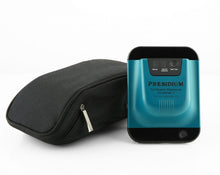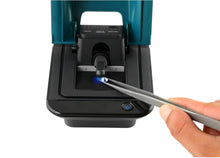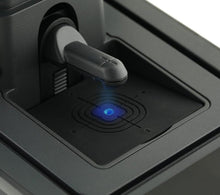PRESIDIUM SYNTHETIC DIAMOND SCREENER (SDS)
ASSURE TESTED 100% ACCURATE WHEN TESTING SYNTHETIC STONES
Identifies Synthetic (Lab-Grown) Diamonds including Mounted Diamonds through its low UV absorption
The Synthetic Diamond Screener is developed to help screen out Type IIa colorless diamond, which is likely to be synthetic and created through chemical vapor deposition (CVD) or high pressure high temperature (HPHT) syntheses, from the natural Type Ia colorless diamond.
When subjected to this deep UV irradiation, Type Ia and Type IIa diamonds each absorb different amount of UV light. Type IIa diamonds allow more deep UV light to pass through and thus its UV light absorption ability is low. This difference in the light absorption is significant enough to aid in differentiating between colorless Type Ia and Type IIa diamonds.
Works on both mounted (with open-back setting) and loose diamonds.
Can be powered by 4 AAA batteries for product mobility or through its USB port connected to external power source.
The Synthetic Diamond Screener is developed to help screen out Type IIa colorless diamond, which is likely to be synthetic and created through chemical vapor deposition (CVD) or high pressure high temperature (HPHT) syntheses, from the natural Type Ia colorless diamond. When subjected to this deep UV irradiation, Type Ia and Type IIa diamonds each absorb different amount of UV light. Type IIa diamonds allow more deep UV light to pass through and thus its UV light absorption ability is low. This difference in the light absorption is significant enough to aid in differentiating between colorless Type Ia and Type IIa diamonds. Works on both mounted (with open-back setting) and loose diamonds. Can be powered by 4 AAA batteries for product mobility or through its USB port connected to external power source.
Features
Advanced technology that measures a diamond’s UV light transmittance ability
2 color coded (blue/red) indicator light bars to give a low or high reading of UV light absorption with blue light indicating Natural Diamond and red light indicating Type IIa Diamond
Instantaneous clear results within 6 seconds
Exterior base foam padding to ensure non-slip sturdiness and prevent scratches to surfaces
Stream-lined ergonomic design that enhances portability and stability
Low battery indicator
Energy-saving auto power-off of device after 10 minutes without operation
Interior LED light source and testing area
Energy-saving auto power-off of interior LED light source when lid of device is open or when Start Test button is not activated
USB port for alternative power source and connectivity
Benefits
Help to screen out Type IIa diamonds likely to be synthetic diamonds
Tests on diamonds within a range in dimension from 2 mm in width and up to 6mm in height (approx. 0.1 to 10 carat size)
Tests on polished diamonds of popular cuts such as brilliant round cut, emerald cut, baguette cut, etc
Can be used on both loose and mounted diamonds (on jewelry with open-back setting)
For use on colorless diamonds from D Color down to J Color
Specifications
Power & Battery
4 x AAA alkaline batteries
USB port to be used with USB cable and appropriate Presidium Universal USB Power Adapter
Recommended Operating Conditions
Only for Colorless Diamonds of:
Color Grade: D Color to J Color
Carat Size: 0.2 carat to >10 carats
Cut: For all cuts as long as gemstone has a flat surface
Mounted Jewelry: For jewelry with “open-back” setting
Dimensions & Weight
Length: 130mm (5.12 inches)
Width: 100mm (3.94 inches)
Height:65mm (2.56 inches)
It is important to note that this is not a diamond tester. You must be quite certain that you are 'screening' known diamonds. So please do not buy this if you are not already an expert in diamonds, or if you do not already have a diamond tester (or a diamond tester with a Moissanite tester, or a Multi Tester).
Technical:
a serious tester for the professional jeweler, it helps screen out Type IIa diamonds, these are very rare in nature (2%) but, currently, all synthetic (CVD and HPHT) diamonds are of this type. For color range D to J.
Non-technical:
Synthetic diamonds are diamonds, they are real diamonds! They are grown by man in a laboratory instead of being grown by nature in the ground. Do not confuse this with a ‘simulant’ - a stone that might look like a diamond but is not. Since synthetic diamonds are the same as natural diamonds, they are extremely difficult to detect, and up to now the only testers were expensive. This is the first low-cost synthetic diamond tester and the only one that will test stones mounted in jewellery.
Q. What is a type IIa diamond?
A. Type II diamonds (including Type IIa and Type IIb) have a very slightly different atomic structure to Type I diamonds. This makes no difference to the appearance of the diamonds (even to the greatest expert) and no difference to the value, it's just a quirk of nature that makes it possible to detect Type IIa. All synthetic diamonds (grown by the CVD or HPHT methods) are Type IIa.
Q. So does that mean if a diamond registers Type IIa it must be synthetic?
A. No, it means that there's a very high chance that it's synthetic, but there's till about a 2% chance that it is natural.
Q. It says, above, "currently, all synthetic (CVD and HPHT) diamonds are of this type" does that imply that this is likely to change?
A. The makers of synthetic diamonds strive to make them so completely identical to natural diamonds that they cannot be distinguished, even on the most expensive machine. Nobody can predict what might happen in the future, but at the moment the two methods used for growing gem-quality diamonds are CVD and HPHT.
Q. If synthetic diamonds are so difficult to detect, and the end product is identical to natural diamonds, why all the fuss?
A. it is standard within the gem / diamond trade to 'disclose' whether a stone is natural or synthetic. Once a synthetic stone (any gemstone, or diamonds) cannot be distinguished from its natural counterpart (not by the greatest expert, not by the most expensive machine) then the two become 100% identical. This then poses a problem for the suppliers of the natural stones, e.g. De Beers, who have been concerned, for the last 50 years, that relatively cheap synthetic diamonds could flood the world market. So within the diamond trade, the issue of synthetic diamonds versus natural diamonds is important; for the end-user, each type is as 'real' as the other, and even for the expert, they are extremely difficult to tell apart.
Q. What is CVD and HPHT?
A. They are two methods of growing diamonds that can be used for jewellery.
CVD (chemical vapor disposition) is a type of plating, a mixture of gases is microwaved (or treated with lasers or an electron beam) which causes diamond to crystallize around a 'base' (substrate). Although we are concerned only with gem diamonds, the process is more commonly used in the electronics and optics industries to 'plate' components with diamond.
The HPHT (high pressure high temperature) method involves taking a 'seed' of diamond, and subjecting it to very high pressures and temperatures in a mixture of molten metals (just as they are formed deep in the Earth), a diamond grows around the 'seed'.
There are other methods of synthesizing diamonds but the resulting 'stones' are too small to be used in jewellery, they are used in industrial processes.
Q. ...and the point is??
A. It is possible that, one day, someone will invent another method of growing gem quality diamonds which cannot be detected on the Presidium SDS, that is why we say it is suitable for synthetic diamonds that are grown using the CVD or HPHT processes.
Q. Is there anything else that needs to be mentioned about the limitations of the Presidium SDS?
A. - it works on colorless diamonds, i.e. color range D to J, not colored diamonds.
- it works with diamonds of size from 2mm width and up to 6mm high (approx. 0.1 to 10 carat).
- it works with both loose stones and stones mounted in jewellery, mounted stones must have an open back setting.






